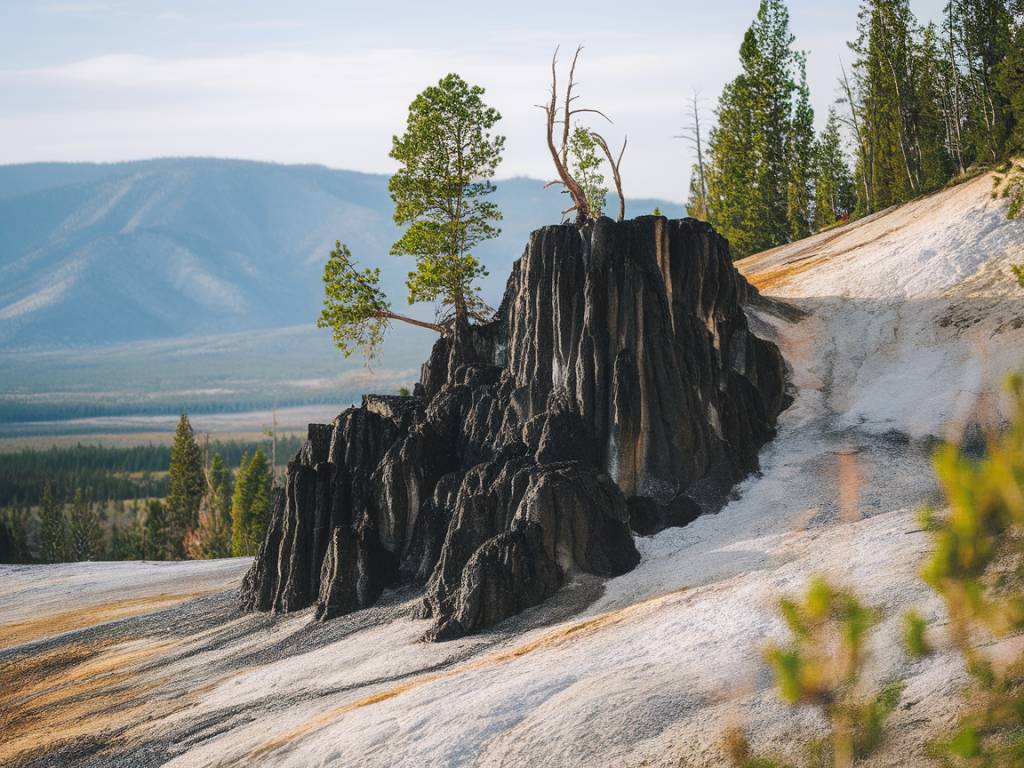Yellowstone National Park, renowned for its geothermal activity and stunning landscapes, is home to numerous fascinating sites. Among these, Obsidian Cliff stands out as a geological marvel with deep historical significance. Located in the northwestern part of the park, Obsidian Cliff offers visitors a unique opportunity to explore the interplay between nature’s forces and human history.
Geographical and Geological Overview
Obsidian Cliff is situated along the Mammoth-Norris road, easily accessible for those eager to witness its grandeur. The cliff itself is composed primarily of black volcanic glass, also known as obsidian, which results from rapidly cooled felsic lava with minimal crystal growth. This natural glass formation is both beautiful and scientifically significant.
Rising about 150 feet above the ground and extending over half a mile, Obsidian Cliff is a striking feature in the park’s landscape. The cliff’s obsidian flows date back approximately 180,000 years, a relative newcomer compared to some of Yellowstone’s older geological formations. Its formation is closely tied to the volcanic activity that shaped much of the region’s terrain.
Historical Significance
Obsidian Cliff is not just a geological wonder; it also holds historical importance. For thousands of years, Native American tribes extensively utilized this rich source of high-quality obsidian to craft tools and weapons. The sharpness and durability of obsidian made it a prized material for producing arrowheads, spear points, and cutting tools. By examining artifacts found across North America, archaeologists have traced the distribution of Obsidian Cliff’s obsidian, uncovering trade networks that spanned vast distances and connected diverse cultures.
Archaeological Discoveries
Archaeological excavations in the vicinity of Obsidian Cliff have yielded numerous artifacts, revealing the significance of this site in prehistoric trade and daily life. The obsidian from this cliff has been found as far away as the Ohio River Valley, indicating its value and the extensive reach of early trade routes.
Not only does Obsidian Cliff provide insight into the technological advancements of ancient peoples, but it also serves as a testament to their adaptability and ingenuity. The artifacts uncovered here offer a glimpse into the past, allowing us to appreciate the complex societies that once thrived in North America.
Flora and Fauna
Obsidian Cliff is enveloped by a diverse ecosystem that supports an array of flora and fauna. The forested area surrounding the cliff is home to various species of trees, including lodgepole pine, Douglas fir, and Engelmann spruce. These trees create a lush canopy that offers habitat and sustenance for wildlife.
Visitors to Obsidian Cliff might encounter animals such as:
The presence of such wildlife enhances the experience of visiting Obsidian Cliff, providing opportunities for wildlife observation and photography. It’s essential to maintain a safe distance from animals and follow park guidelines to ensure both your safety and the well-being of the wildlife.
Visitor Experience
When planning your visit to Obsidian Cliff, there are several things to keep in mind to make the most of your experience. The cliff is readily accessible via a short hike from a nearby parking area. An interpretive trail along the base of the cliff provides informative signage about the geological and historical significance of the site.
Here are some tips to enhance your visit:
Visiting Obsidian Cliff provides a unique blend of natural beauty and historical context, making it an enriching experience for all who venture here.
Conservation Efforts
Preserving Obsidian Cliff’s natural and historical integrity is crucial for future generations. Yellowstone National Park has implemented various measures to protect this site from damage and degradation. Visitors are encouraged to practice Leave No Trace principles, such as not disturbing the natural environment and avoiding the removal of any obsidian pieces.
Researchers and park staff continue to study Obsidian Cliff, ensuring that its history and natural formations are preserved. By learning about and respecting the site’s significance, visitors can contribute to its ongoing conservation.
Final Thoughts: Why Obsidian Cliff Should Be on Your Yellowstone Itinerary
Obsidian Cliff offers visitors a chance to delve into the geological and historical tapestry of Yellowstone National Park. Its striking black formations, rich history of Native American use, and surrounding natural beauty make it a must-see destination within the park.
If you are planning a trip to Yellowstone, adding Obsidian Cliff to your itinerary provides a unique opportunity to explore a lesser-known, yet profoundly significant, part of the park. Whether you’re a geology enthusiast, history buff, or nature lover, Obsidian Cliff has something to captivate your interest and imagination.
As you stand before the sheer face of Obsidian Cliff, you’ll not only witness the power of Earth’s geological processes but also feel a connection to the early inhabitants who once relied on its resources. This convergence of natural wonder and human ingenuity makes Obsidian Cliff a standout destination, embodying the essence of Yellowstone’s diverse offerings.
